
Why do stretching heroes have such a bad rap? Plastic Man was one of the biggest characters during the Golden Age of Comics, and outlived almost all of DC's stable by maintaining a solo series into the 1950s. Elongated Man was one of the first Silver Age heroes, created so that DC could have a Plastic Man of its own, and proved popular enough to push Martian Manhunter out of Detective Comics and take J'Onn's place in the Justice League. In fact, Ralph appeared in far more issues of that team's book than J'Onn, at least until the late '90s. Plus, cast an eye towards Marvel, and you'll see Mr. Fantastic is an institution over there, so what gives?
"Comedy." Someone decided somewhere along the way that stretching heroes should be "funny." All evidence clearly points to the contrary, the take consistently fails, and yet creators insanely stick to the sour formula. Plastic Man was Woozy Winks' straight man. Sue Dibny was Ralph's foil. So why are we stuck with Elongated Man as a nose-wiggling lame-o instead of getting drawn by Bart Sears doing something bitchin'?

More Impel DC Cosmic Cards
- Bronze Tiger at DC Bloodlines
- Darkseid at The Idol-Head of Diabolu
- Golden Age Cheetah at Diana Prince: Wonder Woman
- Peacemaker at Power of the Atom

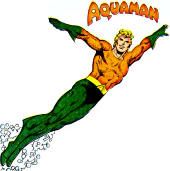
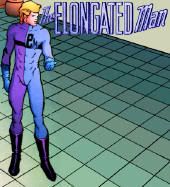
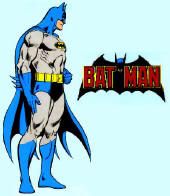
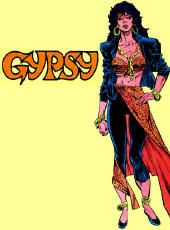

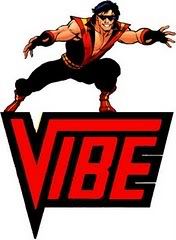
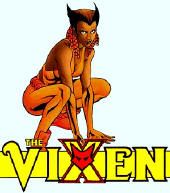

13 comments:
I like Ralph and thought this post was pretty thought-provoking. I think stretching powers are a little far fetched even for comics, so that is probably one reason writers don't take those characters too seriously. I think DC Comic's Elongated Man's code name holds back. A better code name would help him appear more serious. Although, there is a need for some funny heroes to balance out the serious Batman-type ones.
Scott, there are few writers in super-hero comics who can intentionally produce comedy, but I'm happy when it comes together. What bugs me is the groupthink that all stretchable super-heroes must be defined as the comic relief.
For instance, Guy Gardner was one of the funniest members of the JLI because he took himself so seriously, it made him ridiculous. By the same token, Blue Beetle and Booster Gold got on my nerves when they were trying to be funny, and only made me chuckle when they talked like normal people would (although at humorously inappropriate times.) I don't mind rubber people bringing levity, but once it becomes their primary character trait and mission in fictional life, I think reader's can smell the desperation.
You're also right about that name. "Elongated Man" could work for a villain, but it's box office poison for a hero.
I totally agree that stretching heroes don't have to be funny. While I like Ralph being funny when it's written correctly, I prefer Mr. Fantastic's serious nature.
Nice write-up. I'm loving all the card posts you've done! Nice way to tie your blogs together!
The Irredeemable Shag
http://onceuponageek.com
http://firestormfan.com
I think Ralphs main role should always be the detective, rivaling with Batman. EM would probably be more practical, less dependent on the lab (since he doesn't use tools) and more of a people person (less Grissom, more Columbo or Fletcher). As that kind of 'tec, he had a unique role in the DCU.
As comic relief, I say ok, but less Lewis, more Seinfeld. The contradiction with Ralph is that despite having all for physical comedy, he goes for observation, following the Thin Man formula. Going all Jerry Lewis worked awfully for Gerard Jones, who is probably the reason nobody wanted the character after he was done with JLE (despite being one of the longest staying members of the JL by that point). Ralph is only well handled as a funny guy when he is limited to making smartass observations, Waid, Giffen and DeMatteis were good at this. This fits him as a detective and pays homage to Nick Charles. During the satellite era, he distinguished himself from the rest of the square jaws by being like that. He was also the laid back of the group, doing stuff like distracting Hawkman from monitor duty with videogames.
Sorry the Elongated Man coverage has been so thin around these parts lately, Rafa! Keeping up with Vixen and Aquaman has eaten up 2011, but I plan to swap them out in 2012 for more Ralph, Steel and Zee. Anyway, I really enjoyed your observations on Ralph, and if I'd seen more of the guy you described in my own comic reading, I'd be a bigger fan. I missed out on the Silver Age and most of the Bronze, getting stuck with Gerry Jones and the like...
Well, I'm looking forward to that! Ralph and Zee are a good combination; they have a somewhat similar history.
Don't expect something mind blowing from the Ralphster. I often wonder how come I became such a big fan. The greatest stories are exactly the ones that got me hooked: Formerly Known as JL, Identity Crisis, I Can't Believe Not The Justice League and 52. After that, the most notorious work would be Showcase Presents the Elongated Man, which is great, but only if you like silver age stuff, which is mostly written for children. The art is the highlight, but there's a certain neatness about the writing style and the dialog - it feels like watching Bewitched.
After that there are the 'tec stories that are missing from the Showcase, some from Flash (Ralph once became a villain and killed Barry) and DC Presents. 5 really cool hidden jewels I managed to find are Mike Barr's 'tec #500 (the Dibnys solve the historic mystery about the death of Poe) and 572 (EM teams up with Batman, Slam Bradley and Sherlock Holmes against a Moriarty), Justice League Quarterly #6 (a birthday mystery by Waid), Gotham Knights #41 and DC Comics Presents: Mystery in Space.
Ralph does have his moments during the Satellite era, but they are as silly as the average bronce era story. They didn't use him properly in JLE (he basically just made unfunny comments), Sue was more developed during that era. Europe '92 sucks. I think that Gerard Jones did a lot of damage to the character.
Oh, they also appeared in Starman, but the characterization sucked.
Ah, see, I got the right material too late. I read all of the modern books except the second half of 52. I liked Ralph in all of those, but after bad Dibny throughout my '80s & '90s exposure, the balance never turned sufficiently toward the Elongated Man's favor. I used to really hate him, and now I'm just neutral. DC Silver Age material isn't generally my bag, and I have a powerful aversion to Carmine Infantino. That pretty much leaves the '70s as my best hope. I've got one or two DC Comics Presents in my "to read" pile for next year, and it only takes one strong hook in a story to get me rethinking a character. I do (did) like Sue, and I thought they were both good in the latter JLD stories.
Do you hate 80s Infantino or even his silver age stuff? cuz the later is a mayor turn on for anyone who likes architecture, design or fashion. You can almost hear a Bossa Nova or 50s Sinatra soundtrack. Kinda like the first Pink Panther movie.
Nevermind that, if you don't enjoy classic Infantino or Gardner Fox, forget about it. Go for the 5 hidden jewels I mentioned. A bit after reading 52, I read just the Ralph scenes, writen by Waid and Morrison, and I found it quite good. There's a list of those issues in the Pop Cult article I made (http://www.pop-cult.net/Wikitainment/index.php/Elongated_Man). There are also the 3 minutes of JLU lines voiced by the fantastic Jeremy Piven that you can find in Youtube. I can't believe they got him just for that.
Some people love his participation in the "Grand Gignol" story of Starman. I don't. Found it cloying and out of character.
Besides anything written by Gerard Jones, I'd avoid Justice as references for Ralph.
Also, I've never asked, why Justice League Detroit, anyway? Do you like this era better than the rest or do you just find it oddly fascinating?
I haven't had enough exposure to classic Infantino to have formed a passionate opinion. What I have seen though, I don't like, unless an inker like Murphy Anderson is involved. I do like that cosmopolitan art style in general though, and Joe Certa's adopting it late in his Manhunter from Mars run was a blessing. I'd say my main problem with Infantino is the broad, flat, angular faces. Everybody looks vaguely thuggish.
As for the rest, everything goes better with Piven. When I start exploring Elongated Man next year, I'm going to have to do some reading/linking up on your material. I'm still struggling with all things internet after abandoning other people's blogs in my last months of school.
The 9/12ths of "Justice" I read seemed to be pretty good with Ralph, but I reckon that's more a tangent than a reply.
Why Detroit? Back when I ran a Martian Manhunter fan site in the late '90s, the WebTV program forced me to create multiple sites in order to be able to load and edit them on my own set top box. When I started my Martian Manhunter blog, I still thought that was a valid organizational system. I set up this blog specifically as storage space for the Manhunter blog to link to. Pretty much a happy accident. This blog picked up its own separate following, and I began exploring the other team members in response, and found them all interesting enough to write about. Relative to the other Justice Leagues, I like this line-up better than most, and I think the stories are much better than they're given credit for. I couldn't imagine doing any other version in their own spotlight blog, especially since I will eventually fold JLTF coverage into this one.
Justice was pretty good to Ralph in terms of panel space; however, I get a bit neurotic when he's out of character. He's an optimistic phlegmatic with a vision of abundance. The man has it all, and is an intimate friend of Flash, Batman and Superman, which is why I see some scenes like his insecurity about not being targeted or not being the only stretcher of the JLA as nonsense. He's also well aware that the JLA features members with repeated powers. Robinson, although well intended, ended up doing the same in Starman. Classically, the insecuere characters of the JLA are the Atom and Red Tornado. Steve Englehart explored that.
Infantino changed his style during the 70s. In the early 60s, most of his characters looked nerdy with big heads, then they looked more normal. I love his scratchy style when he inks himself.
Well, I'm really glad that you're covering Detroit. I know there's another about the satellite. Too bad there isn't one about the Bwahaha era.
It's interesting that you brought up Englehart's Atom, because I see that as the point of divergence from the Silver Age interpretation of the character that largely matches your take on Elongated Man. My armchair psychoanalysis of Ray Palmer is that he's an egotist whose pursuit of Jean Loring was based on the completion of his idealized life to date. He's brilliant, athletic and usually secure, in sharp contrast to the motivation of the Golden Age Atom, Al Pratt. After Englehart, the Atom became another in the endless list of Peter Parker proxies, questioning his role and worth to the Justice League. I find that neurosis perfect for some characters, but this obsession with "relatability" ruins other characters upon which it is ill-applied. I think it comes from fans-turned-professionals who take their personal biases and verbalize them through characters.
I suspect that this was Aquaman's bane of the last forty years. Fan writers decided that he was a B-list character who talked to fish and lost more battles than he won, despite his being a globally recognized and often revered character. It took Geoff Johns to finally asserted that Aquaman was a great character with the confidence to sell it to the public, and people wanting admirable, capable heroes are buying. Self-deprecating Atoms and hypersensitive goofball Elongated Men have no broad appeal, and so cannot gain traction if that's the only model anyone is writing. Instead of playing to their offbeat powers/identities, they succumb to them.
Since James Robinson draws heavily from the Bronze Age, it makes sense he would perpetuate these interpretations. Thankfully, he was much more kind to Ray Palmer than to Ralph. The protests against the Atom's portrayal in "Cry For Justice" perplexed me, because with the exception of Justice League of America, he was always a self-justifying hardliner willing to go to extremes before they were fashionable. With better art and publicity, he could have ridden the anti-hero wave of the 1980s.
I'm really surprised that no one has taken on the JLI, given its widespread and deep love among fans. I really enjoyed those comics, but I just don't have much interest in any but a few of the featured characters.
Say, this has been a fascinating and enlightening discussion. Would it be okay if I edited it into an actual post? It seems a shame to leave such deep analysis buried in the comments to a year old post. After purging a bunch of blogs I had limited time or interest in pursuing from my Google Reader last year, I've been really resistant to adding any more. However, I've enjoyed this so much, I'm going to start following your blog directly...
FYI - I've been quietly lurking your discussion back and forth. I agree with Frank that this would make a good blog post. And I'll also be following your Elongated Man blog, and link to it from FIRESTORM FAN!
The Irredeemable Shag
http://firestormfan.com
Frank,
I've read very few Atom stories before Englehart's run on JLA, but you're right, I can't remember him being insecure before that.
According to me, most of the characters developed what I call proto-personalities in the 70s. They stop being the same guy with different clothes, name and hair color, to have distinctive personalities, albeit very rough ones. Grumpy, Sleepy and Doc, type of personalities, like the Smurfs. Batman became the smart one, Ollie the stubborn liberal, Hawkman the stiff, Ralph the spoiling laid back, practical guy, Atom the insecure, Red Tornado the insecure tin man, Aquaman was still the merry man who talks to fishes, Black Canary the liberated feminist, Diana the princess, Superman the boy scout, and so on. In the 80s, they developed deeper personalities.
I also agree that some writers have translated the fact that some characters are B-list to the public to their own fame within DC. A character might only appear in a single panel never to be seen again; however, if the story says so, he might be more popular than Superman within the DC world. Following this principle, Aquaman is the king of one of the greatest countries of the DC Earth and the Elongated Man is an entertainer that gained a fortune in a sec, married a NY socialite and joined the JLA. According to the silver and bronze age, they rarely or never lost a case.
Also, by all means, turning this conversation into a post sounds like a great idea. Maybe we can do it both as some sort of crossover thing. I’ll place a link to the JLD blog after introducing you. The part in which we talk about turning it into a blog would be like reading metafiction, and me mentioning so would be like metafiction to metafiction. It’s a post about a series of comments in which we eventually talk about turning it into a post, and then, about how such post would have us talking about talking about that and the fact that it is like metafiction… My head hurts…
Post a Comment